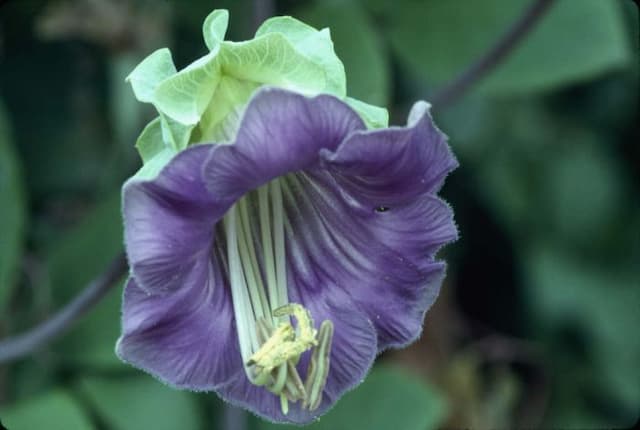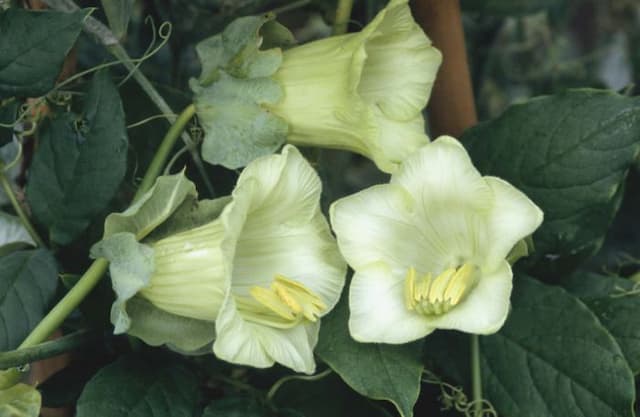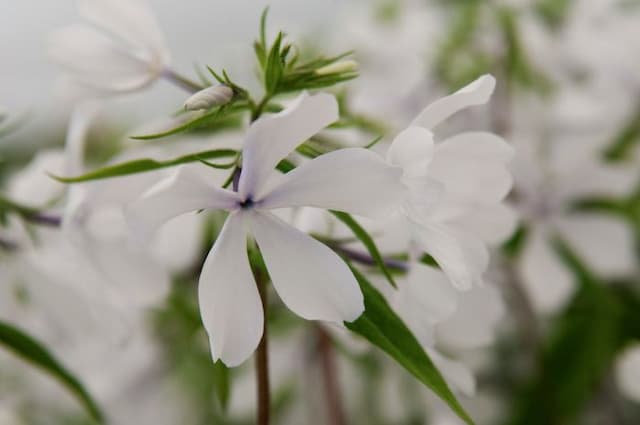Moss Phlox Phlox subulata 'Marjorie'

ABOUT
The Phlox subulata 'Marjorie' is a vibrant ground cover known for its dense, mat-forming habit. Its appearance is highlighted by a profusion of flowers that typically bloom in the springtime. The blossoms of 'Marjorie' are a delicate shade of pink, often described as pastel, with each petal exhibiting a lighter center and darker margins, creating a lovely bi-color effect. This distinctive color pattern adds depth and contrast to the floral display. The petals are narrow and slightly elongated, radiating outwards from a small center to form a classic, flat, five-petaled flower shape that is common among creeping phlox varieties. The foliage of the 'Marjorie' variety is equally appealing, comprised of needle-like leaves that remain evergreen throughout the year in milder climates. These leaves are small and narrow, creating a fine texture that complements the softness of the blooms. The color of the leaves is a deep green, which forms a beautiful backdrop that makes the pink flowers stand out even more prominently. Overall, the appearance of Phlox subulata 'Marjorie' is characterized by its lush floral carpet and verdant foliage, offering a striking visual impact ideal for rock gardens, borders, and as a colorful ground cover in any landscape design. Its growth habit creates a continuous blanket of color when in bloom, which is both eye-catching and charming.
About this plant
 Names
NamesFamily
Polemoniaceae
Synonyms
Moss Phlox, Creeping Phlox, Mountain Phlox, Moss Pink, Ground Pink, Moss Pinks, Flowering Moss
Common names
Phlox subulata 'Marjorie'.
 Toxicity
ToxicityTo humans
Phlox subulata, commonly known as Creeping Phlox, is not known to be toxic to humans. There is no widespread evidence that suggests ingestion of Creeping Phlox leads to poisoning, and it is not listed among the common poisonous plants affecting humans. However, as with any non-food plant, individual allergies or sensitivities could cause mild reactions, but this is not typical. In general, Creeping Phlox is considered safe and is not associated with serious consequences if ingested.
To pets
Creeping Phlox is not typically toxic to pets either. It is generally considered a safe plant in gardens where pets may roam. There is no significant evidence to suggest that Creeping Phlox would lead to poisoning in pets if they were to ingest it. Though non-toxic, it is still possible for pets to have an individual sensitivity to the plant, which might cause mild gastrointestinal upset, but such cases are uncommon and not well documented. Overall, it is considered a pet-friendly plant.
 Characteristics
CharacteristicsLife cycle
Perennials
Foliage type
Evergreen
Color of leaves
Green
Flower color
Pink
Height
6 inches (15 cm)
Spread
2 feet (60 cm)
Plant type
Herb
Hardiness zones
3
Native area
North America
Benefits
 General Benefits
General Benefits- Colorful Groundcover: Phlox subulata 'Marjorie' provides a vibrant carpet of color in spring, brightening up garden beds.
- Drought Tolerance: Once established, this variety of creeping phlox is very tolerant of dry conditions, requiring minimal watering.
- Low Maintenance: It requires very little care, making it an ideal choice for gardeners who prefer low-maintenance plants.
- Erosion Control: Its mat-forming habit helps stabilize soil and prevent erosion on slopes and banks.
- Attracts Pollinators: The flowers of Phlox subulata 'Marjorie' attract butterflies and bees, promoting pollination in the garden.
- Adaptable: This plant can thrive in a range of soil types, as long as they are well-drained.
- Extended Blooming Period: It has a relatively long flowering season, extending the colorful display in the garden.
- Deer Resistant: Phlox subulata 'Marjorie' is not a preferred choice for deer, reducing the likelihood of damage from grazing.
- Evergreen Foliage: It retains its foliage throughout the year, adding consistent greenery to the landscape even when not in bloom.
 Medical Properties
Medical PropertiesThis plant is not used for medical purposes.
 Air-purifying Qualities
Air-purifying QualitiesThis plant is not specifically known for air purifying qualities.
 Other Uses
Other Uses- Photographic Subject: Phlox subulata, with its vibrant blooms, can be a stunning subject for macro photography, capturing the intricate details of each flower.
- Artistic Inspiration: Artists may use the Creeping Phlox as a muse for paintings, drawings, and other forms of botanical art due to its pleasing aesthetic.
- Educational Tool: Creeping Phlox can be grown in school gardens to teach children about plant growth habits and the importance of groundcover plants in preventing soil erosion.
- Living Mulch: Creeping Phlox can serve as a living mulch, providing a natural barrier to weeds while also conserving soil moisture.
- Eco-Friendly Packaging: Dried Creeping Phlox can be used as a biodegradable packing material to protect fragile items during shipping.
- Natural Fabric Dye: The flowers of Creeping Phlox can be boiled to produce a natural dye for coloring fabrics.
- Garden Path Edging: Planting Creeping Phlox along the edges of garden paths can create a soft, natural border that enhances the landscape design.
- Culinary Decoration: Edible varieties of Creeping Phlox petals can serve as decorative elements on cakes and desserts, after ensuring they are free from pesticides.
- Scented Sachets: The dried flowers of Creeping Phlox can be used to fill scented sachets, providing a natural fragrance for drawers and closets.
- Model Landscaping: Creeping Phlox can be used in miniature scale models or fairy gardens to represent larger plant species due to its small size and dense growth.
Interesting Facts
 Feng Shui
Feng ShuiThe Creeping Phlox is not used in Feng Shui practice.
 Zodiac Sign Compitability
Zodiac Sign CompitabilityThe Creeping Phlox is not used in astrology practice.
 Plant Symbolism
Plant Symbolism- Harmony: The delicate balance of the Phlox subulata 'Marjorie', or moss phlox, blooms can represent living in harmony, both within communities and the natural world.
- Unity: Often used in gardens to create a carpet of color, the moss phlox symbolizes coming together in unity and creating something beautiful as one.
- Agreement: The ease with which these plants grow side by side has led them to symbolize agreement and the peaceful resolution of conflicts.
- New beginnings: Their tendency to blanket an area in the spring makes them a symbol of fresh starts and new opportunities, coinciding with the season of renewal.
- Sweet dreams: In some cultural contexts, the moss phlox has been associated with calming effects, leading to peaceful sleep and pleasant dreams.
 Water
WaterCreeping Phlox should be watered regularly, especially during its first growing season to help establish a deep, extensive root system. Once established, watering should be done when the top inch of soil feels dry to the touch, which might be approximately once or twice a week, depending on climate conditions. Provide the plant with about one inch of water per watering session which equals about 0.623 gallons per square yard. During hot, dry spells, more frequent watering might be necessary. In general, aim for consistent moisture, but avoid overwatering as this can lead to root rot.
 Light
LightCreeping Phlox thrives best in full sunlight where it can receive at least six hours of direct sun daily. Ideally, it should be planted in a spot that gets unfiltered sunlight for most of the day to encourage maximum flowering. However, in regions with extremely hot summers, some afternoon shade can help protect the plant from excessive heat stress.
 Temperature
TemperatureCreeping Phlox is hardy and can tolerate a wide range of temperatures, making it suitable for many climates. It can survive minimum winter temperatures down to -20 degrees Fahrenheit. The ideal temperature conditions for active growth are between 60 and 70 degrees Fahrenheit. However, Creeping Phlox is quite adaptable and can handle temperature fluctuations outside these ranges as long as the soil is well-draining.
 Pruning
PruningCreeping Phlox benefits from pruning to stimulate new growth and maintain its shape. Trim the plant lightly after it has finished flowering, usually in late spring or early summer, to encourage a dense habit and possibly a second bloom. Pruning can be done every year or every other year, depending on the plant's performance. The best time for pruning is immediately after the blooming period.
 Cleaning
CleaningAs needed
 Soil
SoilCreeping Phlox (Phlox subulata 'Marjorie') thrives in a well-draining soil mixture with a slightly acidic to neutral pH between 6.0 and 7.0. A recipe for the best soil mix can include garden loam, compost, and coarse sand or perlite to improve drainage. Adding organic matter will enhance soil fertility and structure, supporting robust growth.
 Repotting
RepottingCreeping Phlox (Phlox subulata 'Marjorie') is generally not repotted often as it is a perennial groundcover that prefers to be left undisturbed. It is commonly planted outdoors where it can spread and naturalize without the need for repotting.
 Humidity & Misting
Humidity & MistingCreeping Phlox (Phlox subulata 'Marjorie') is tolerant of a wide range of humidity levels and does not require any specific humidity conditions. As an outdoor plant, it is well-adapted to natural variations in environmental humidity.
 Suitable locations
Suitable locationsIndoor
Ensure bright light and good air circulation for indoor Creeping Phlox.
Outdoor
Plant in sunny spot with well-draining soil and space to spread.
Hardiness zone
3-9 USDA
 Life cycle
Life cyclePhlox subulata 'Marjorie', commonly known as Moss Phlox, begins its life cycle when the seeds germinate in early spring, preferring well-drained soil with moderate moisture and sunlight. Once the seedlings establish, they enter a vegetative stage, growing low to the ground with needle-like leaves, and spreading laterally to form dense mats. Throughout spring, usually between April and June, Moss Phlox transitions to its flowering stage, displaying a profusion of vibrant pink flowers, which attract various pollinators. Following pollination, the plant sets seed, which can drop to the ground and initiate a new life cycle or can be collected for propagation. During summer, the plant continues to grow vegetatively, although at a slower rate as energy is conserved for the following year. In fall and winter, Moss Phlox becomes dormant, with aboveground growth dying back as the plant prepares to survive the cold weather, though its evergreen foliage often remains partially visible, depending on the harshness of the climate.
 Propogation
PropogationPropogation time
Early Spring
Phlox subulata 'Marjorie', commonly known as Moss Phlox, is best propagated through division, which is also the most popular method for this specific cultivar. The ideal time to divide Moss Phlox is in the early spring or early fall when the plant is not in full bloom. To propagate by division, you dig up an established clump and gently separate it into smaller sections, each with a good root system and several shoots. These sections can then be replanted immediately in well-prepared soil, ensuring they are planted at the same depth as they were previously. Care should be taken to water the new divisions regularly until they are established, which ensures they'll continue to grow and thrive in their new locations.









